Abstract
Changes in the QT and QTc intervals were studied in 16 patients by atrial pacing at rates of 100, 130, and 150 beats/minute. In all patients the measured QT shortened when the atrial paced rate was increased, but when corrected for heart rate the QTc lengthened. Intravenously administered propranolol produced a bradycardia and a lengthening of the QT interval in 15 of the 16 patients studied. When the QT interval was corrected for heart rate using Bazett's formula the QTc was shortened in 13 patients, unchanged in one, and lengthened in two. However, when the QT interval was measured at identical atrial paced rates the QT of the 15 patients studied was lengthened in 10 and unchanged in five. In none was the QT interval shortened. These results show firstly that Bazett's formula is unsuitable for correction of QT interval changes induced by atrial pacing, and secondly that, though intravenously administered propranolol usally produces a shortening of the QTc, when its effect is assessed directly by using an identical atrial paced rate the QT interval usually lengthens, or may remain unchanged, but never shortens. It is suggested that the formal assessment of drug induced QT interval changes should be made at identical atrial paced rates.
Full text
PDF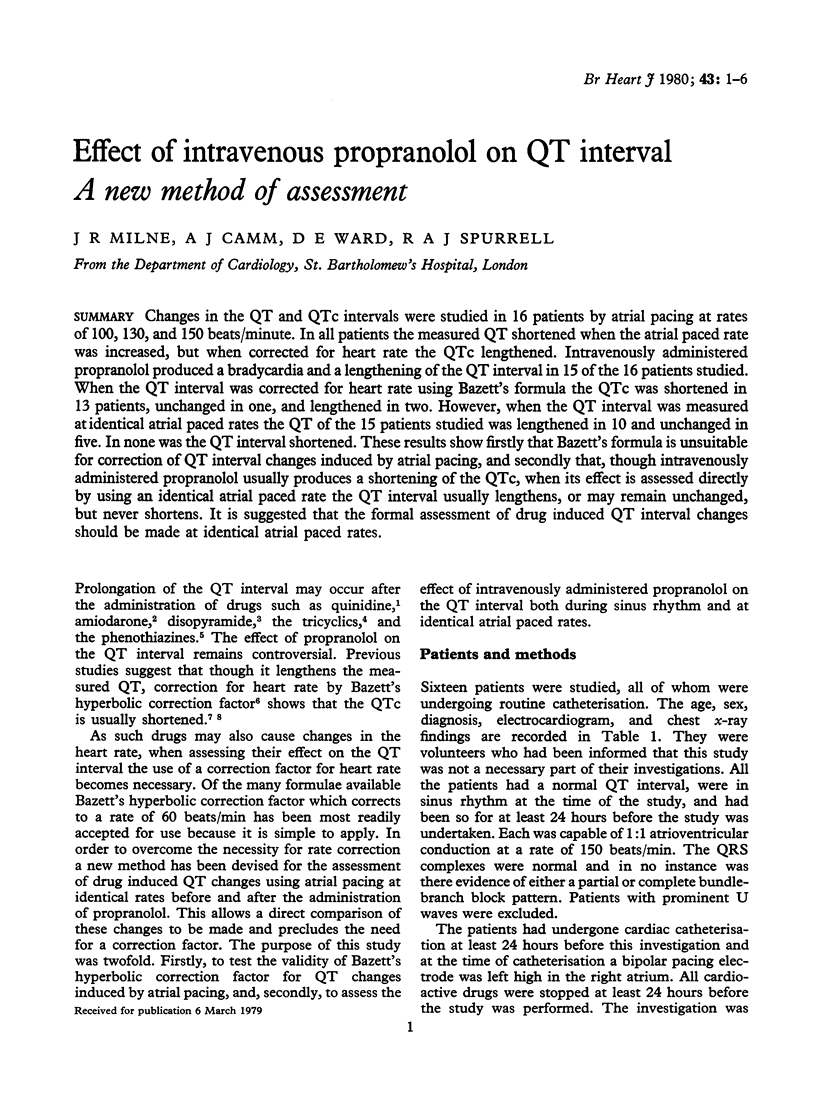

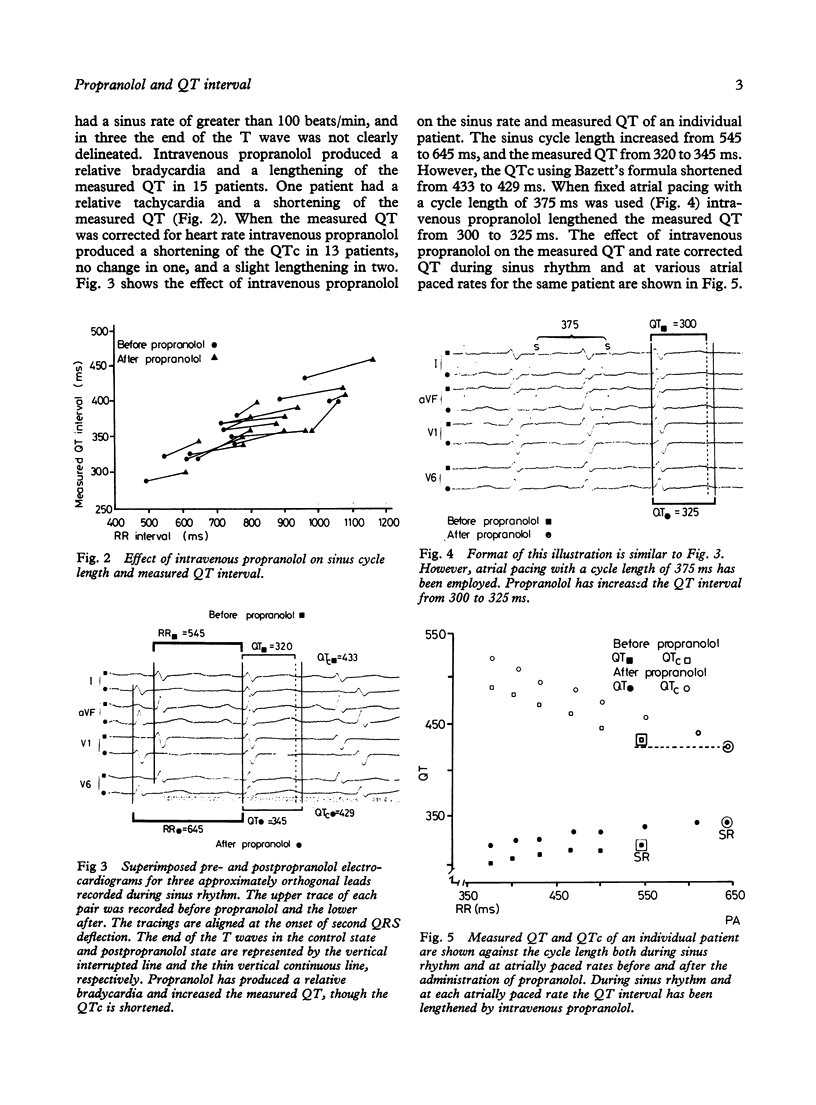
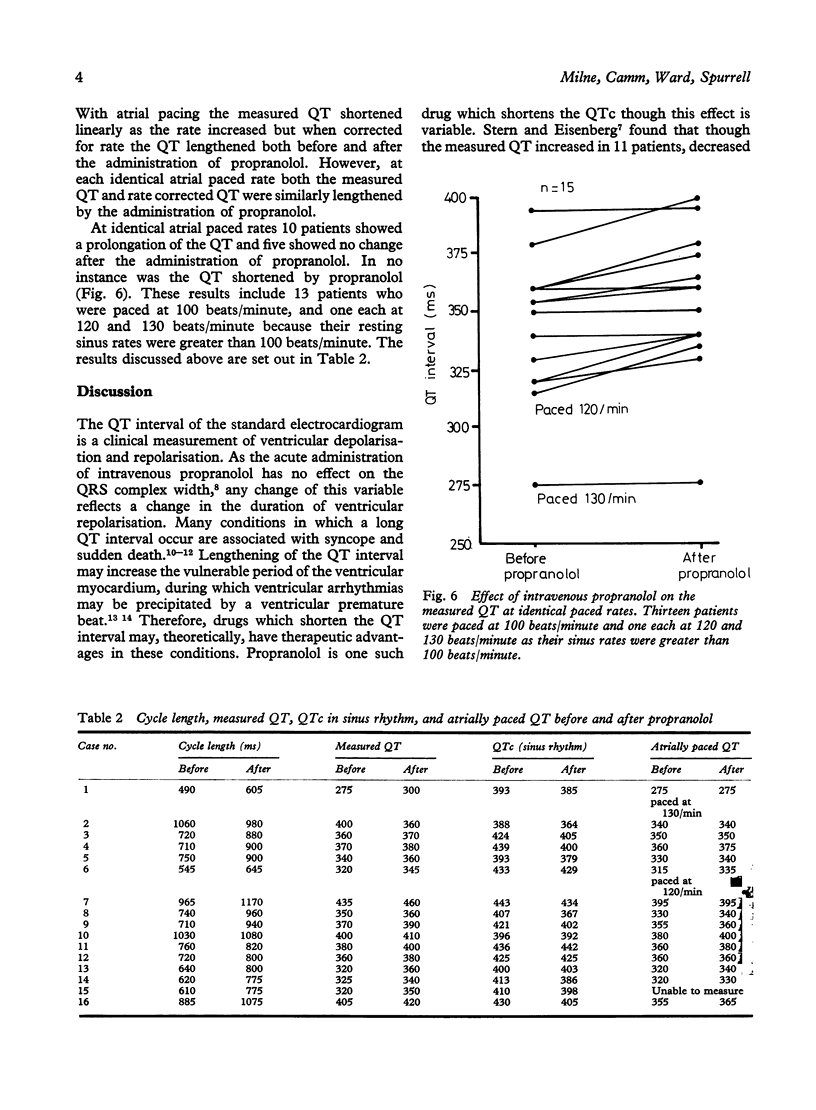
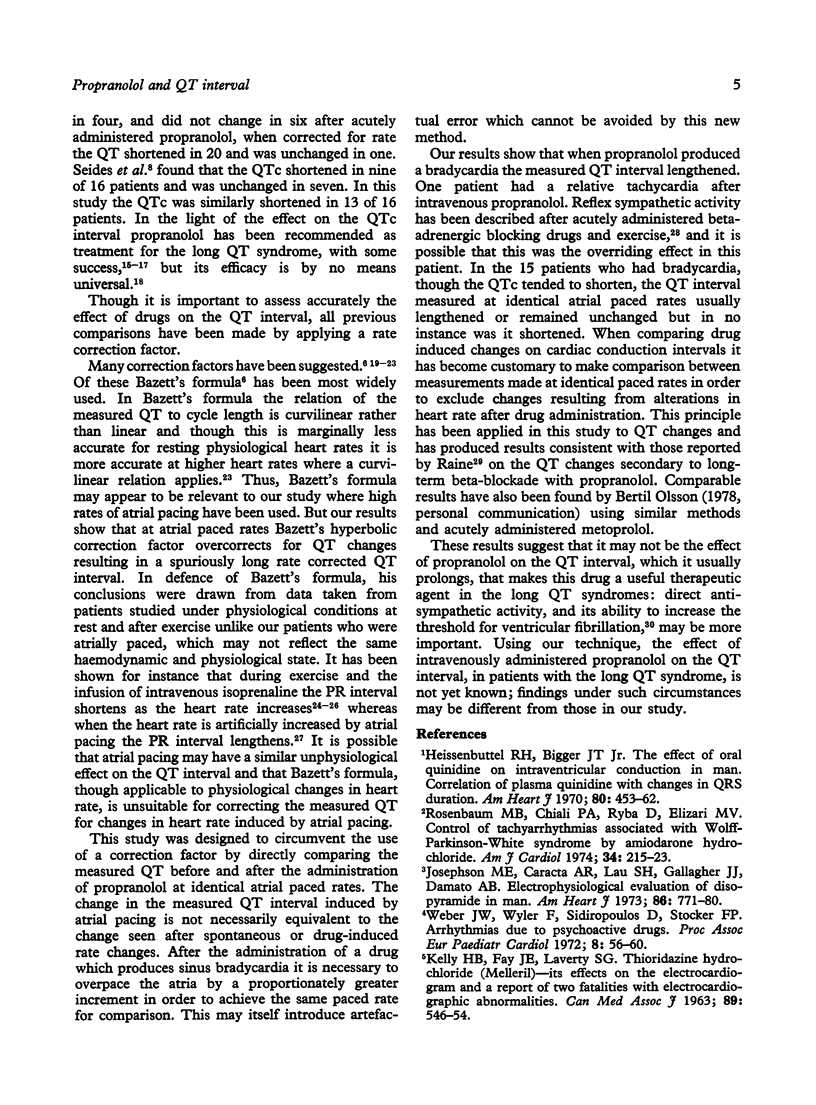
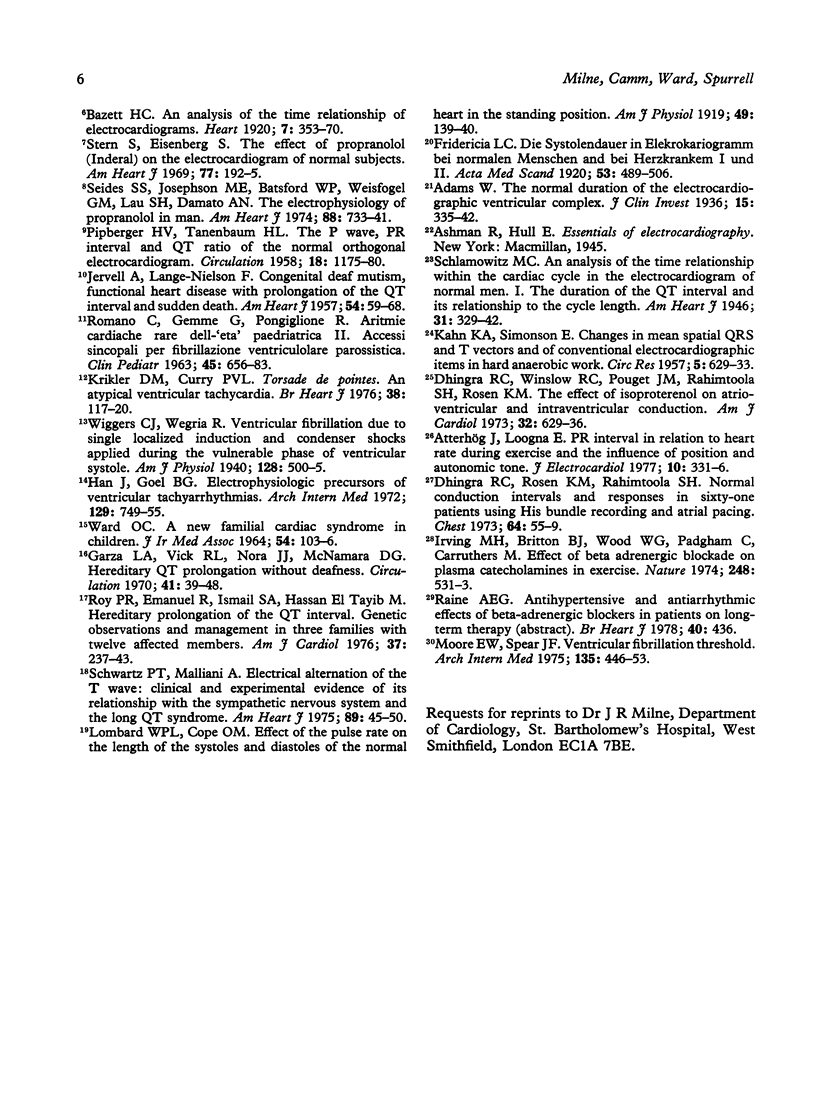
Selected References
These references are in PubMed. This may not be the complete list of references from this article.
- Adams W. THE NORMAL DURATION OF THE ELECTROCARDIOGRAPHIC VENTRICULAR COMPLEX. J Clin Invest. 1936 Jul;15(4):335–342. doi: 10.1172/JCI100784. [DOI] [PMC free article] [PubMed] [Google Scholar]
- Atterhög J. H., Loogna E. P-R interval in relation to heart rate during exercise and the influence of posture and autonomic tone. J Electrocardiol. 1977;10(4):331–336. doi: 10.1016/s0022-0736(77)80005-8. [DOI] [PubMed] [Google Scholar]
- Dhingra R. C., Rosen K. M., Rahimtoola S. H. Normal conduction intervals and responses in sixty-one patients using His bundle recording and atrial pacing. Chest. 1973 Jul;64(1):55–59. doi: 10.1378/chest.64.1.55. [DOI] [PubMed] [Google Scholar]
- Dhingra R. C., Winslow E., Pouget J. M., Rahimtoola S. H., Rosen K. M. The effect of isoproterenol on atrioventricular and intraventricular conduction. Am J Cardiol. 1973 Oct;32(5):629–636. doi: 10.1016/s0002-9149(73)80055-4. [DOI] [PubMed] [Google Scholar]
- Garza L. A., Vick R. L., Nora J. J., McNamara D. G. Heritable Q-T prolongation without deafness. Circulation. 1970 Jan;41(1):39–48. doi: 10.1161/01.cir.41.1.39. [DOI] [PubMed] [Google Scholar]
- Han J., Goel B. G. Electrophysiologic precursors of ventricular tachyarrhythmias. Arch Intern Med. 1972 May;129(5):749–755. [PubMed] [Google Scholar]
- Heissenbuttel R. H., Bigger J. T., Jr The effect of oral quinidine on intraventricular conduction in man: correlation of plasma quinidine with changes in QRS duration. Am Heart J. 1970 Oct;80(4):453–462. doi: 10.1016/0002-8703(70)90191-2. [DOI] [PubMed] [Google Scholar]
- Irving M. H., Britton B. J., Wood W. G., Padgham C., Carruthers M. Effects of beta adrenergic blockade on plasma catecholamines in exercise. Nature. 1974 Apr 5;248(448):531–533. doi: 10.1038/248531a0. [DOI] [PubMed] [Google Scholar]
- JERVELL A., LANGE-NIELSEN F. Congenital deaf-mutism, functional heart disease with prolongation of the Q-T interval and sudden death. Am Heart J. 1957 Jul;54(1):59–68. doi: 10.1016/0002-8703(57)90079-0. [DOI] [PubMed] [Google Scholar]
- Josephson M. E., Caracta A. R., Lau S. H., Gallagher J. J., Damato A. N. Electrophysiological evaluation of disopyramide in man. Am Heart J. 1973 Dec;86(6):771–780. doi: 10.1016/0002-8703(73)90280-9. [DOI] [PubMed] [Google Scholar]
- KAHN K. A., SIMONSON E. Changes of mean spatial QRS and T vectors and of conventional electrocardiographic items in hard anaerobic work. Circ Res. 1957 Nov;5(6):629–633. doi: 10.1161/01.res.5.6.629. [DOI] [PubMed] [Google Scholar]
- KELLY H. G., FAY J. E., LAVERTY S. G. THIORIDAZINE HYDROCHLORIDE (MELLARIL): ITS EFFECT ON THE ELECTROCARDIOGRAM AND A REPORT OF TWO FATALITIES WITH ELECTROCARDIOGRAPHIC ABNORMALITIES. Can Med Assoc J. 1963 Sep 14;89:546–554. [PMC free article] [PubMed] [Google Scholar]
- Krikler D. M., Curry P. V. Torsade De Pointes, an atypical ventricular tachycardia. Br Heart J. 1976 Feb;38(2):117–120. doi: 10.1136/hrt.38.2.117. [DOI] [PMC free article] [PubMed] [Google Scholar]
- Moore E. N., Spear J. F. Ventricular fibrillation threshold; its physiological and pharmacological importance. Arch Intern Med. 1975 Mar;135(3):446–453. doi: 10.1001/archinte.135.3.446. [DOI] [PubMed] [Google Scholar]
- PIPBERGER H. V., TANENBAUM H. L. [The P wave, P-R interval, and Q-T ratio of the normal orthogonal electrocardiogram]. Circulation. 1958 Dec;18(6):1175–1180. doi: 10.1161/01.cir.18.6.1175. [DOI] [PubMed] [Google Scholar]
- ROMANO C., GEMME G., PONGIGLIONE R. ARITMIE CARDIACHE RARE DELL'ETA' PEDIATRICA. II. ACCESSI SINCOPALI PER FIBRILLAZIONE VENTRICOLARE PAROSSISTICA. (PRESENTAZIONE DEL PRIMO CASO DELLA LETTERATURA PEDIATRICA ITALIANA) Clin Pediatr (Bologna) 1963 Sep;45:656–683. [PubMed] [Google Scholar]
- Rosenbaum M. B., Chiale P. A., Ryba D., Elizari M. V. Control of tachyarrhythmias associated with Wolff-Parkinson-White syndrome by amiodarone hydrochloride. Am J Cardiol. 1974 Aug;34(2):215–223. doi: 10.1016/0002-9149(74)90200-8. [DOI] [PubMed] [Google Scholar]
- Roy P. R., Emanuel R., Ismail S. A., El Tayib M. H. Hereditary prolongation of the Q-T interval. Genetic observations and management in three families with twelve affected members. Am J Cardiol. 1976 Feb;37(2):237–243. doi: 10.1016/0002-9149(76)90318-0. [DOI] [PubMed] [Google Scholar]
- Schwartz P. J., Malliani A. Electrical alternation of the T-wave: clinical and experimental evidence of its relationship with the sympathetic nervous system and with the long Q-T syndrome. Am Heart J. 1975 Jan;89(1):45–50. doi: 10.1016/0002-8703(75)90008-3. [DOI] [PubMed] [Google Scholar]
- Seides S. F., Josephson M. E., Batsford W. P., Weisfogel G. M., Lau S. H., Damato A. N. The electrophysiology of propranolol in man. Am Heart J. 1974 Dec;88(6):733–741. doi: 10.1016/0002-8703(74)90283-x. [DOI] [PubMed] [Google Scholar]
- Stern S., Eisenberg S. The effect of propranolol (Inderal) on the electrocardiogram of normal subjects. Am Heart J. 1969 Feb;77(2):192–195. doi: 10.1016/0002-8703(69)90350-0. [DOI] [PubMed] [Google Scholar]
- WARD O. C. A NEW FAMILIAL CARDIAC SYNDROME IN CHILDREN. J Ir Med Assoc. 1964 Apr;54:103–106. [PubMed] [Google Scholar]


